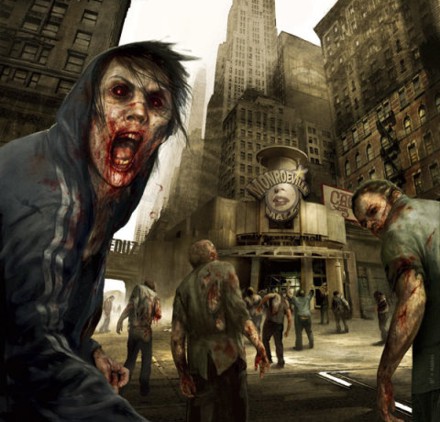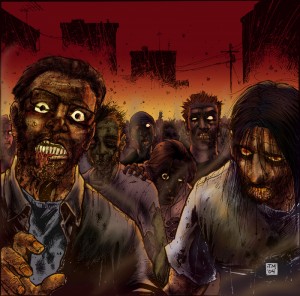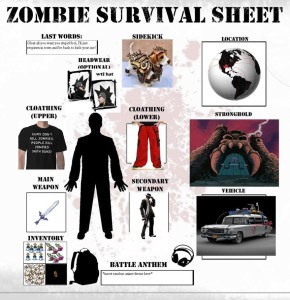Tag Archives: flesh
ZOMBIE HISTORY – The Plague That Is Zombies
 ‘I hereby resolve to kill every vampire in America” writes the young Abraham Lincoln in the best-selling 2010 novel “Abraham Lincoln: Vampire Hunter.” Honest Abe doesn’t quite make good on his promise, and the grim results are all around us. Today, vampires spring from the shadows of our popular culture with deadening regularity, from the Anne Rice novels to the Twilight juggernaut to this year’s film adaptation about the ghoul-slaying Great Emancipator. Lately we’ve also endured a decadelong bout with the vampire’s undead cousin, the zombie, who has stalked films from “28 Days Later” to “Resident Evil” (the next sequel of which is due out this fall) and the popular TV show “The Walking Dead.”
‘I hereby resolve to kill every vampire in America” writes the young Abraham Lincoln in the best-selling 2010 novel “Abraham Lincoln: Vampire Hunter.” Honest Abe doesn’t quite make good on his promise, and the grim results are all around us. Today, vampires spring from the shadows of our popular culture with deadening regularity, from the Anne Rice novels to the Twilight juggernaut to this year’s film adaptation about the ghoul-slaying Great Emancipator. Lately we’ve also endured a decadelong bout with the vampire’s undead cousin, the zombie, who has stalked films from “28 Days Later” to “Resident Evil” (the next sequel of which is due out this fall) and the popular TV show “The Walking Dead.”
Purists will hold forth on the differences between vampire and zombie, but the family resemblance is unmistakable. Both are human forms seized by an animal aggression, which manifests itself in an insatiable desire to feed on the flesh of innocents. (Blood, brains, whatever; it’s a matter of taste.) Moreover, that very act of biting, in most contemporary versions of both myths, transforms the victims into undead ghouls themselves.
Our vampires and zombies (as well as such poor relations as werewolves) all serve as carriers for vaguely similar saliva-borne infections. These mythical contagions are especially odd because they have so few analogues in the natural world. Indeed, there is really only one: the rabies virus.
A fatal infection of the brain, rabies is particularly devastating to the limbic system, one of the most primitive parts of the brain. Fear, anger and desire are hijacked by the virus, which meanwhile replicates prolifically in the salivary glands. The infected host, deprived of any sense of caution, is driven to furious attack and sometimes also racked with intense sexual urges. Today we know that most new diseases come from our contact with animal populations, but with rabies this transition is visible, visceral, horrible. A maddened creature bites a human, and some time later, the human is seized with the same animal madness.
Known and feared for all of human history—references to it survive from Sumerian times—rabies has served for nearly as long as a literary metaphor. For the Greeks, the medical term for rabies (lyssa) also described an extreme sort of murderous hate, an insensate, animal rage that seizes Hector in “The Iliad” and, in Euripides’ tragedy of Heracles, goads the hero to slay his own family. The Oxford English Dictionary documents how the word “rabid” found similar purchase in English during the 17th century, as a term of illness but also as a wrenching state of agitation: “rabid with anguish” (1621), “rabid Griefe” (1646).
The roots of the vampire myth stretch back nearly as far. Tales of vampire-like creatures, formerly dead humans who return to suck the blood of the living, date to at least the Greeks, before rumors of their profusion in Eastern Europe drifted westward to capture the popular imagination during the 1700s.
In its original imagining, though, the premodern vampire differed from today’s in one crucial respect: His condition wasn’t contagious. Vampires were the dead, returned to life; they could kill and did so with abandon. But their nocturnal depredations seldom served to create more of themselves.
All that changed in mid-19th century England—at the very moment when contagion was first becoming understood and when public alarm about rabies was at its historical apex. Despite the fact that Britons were far more likely to die from murder (let alone cholera) than from rabies, tales of fatal cases filled the newspapers during the 1830s. This, too, was when the lurid sexual dimension of rabies infection came to the fore, as medical reports began to stress the hypersexual behavior of some end-stage rabies patients. Dubious veterinary thinkers spread a theory that dogs could acquire rabies spontaneously as a result of forced celibacy.
Thus did rabies embody the two dark themes—fatal disease and carnal abandon—that underlay the burgeoning tradition of English horror tales. Britain’s first popular vampire story was published in 1819 by John Polidori, formerly Lord Byron’s personal physician. The sensation it caused was due largely to the fact that its vampire, a self-involved, aristocratic Lothario, distinctly resembled the author’s erstwhile employer.
But Polidori’s Byronic ghoul only seduced and killed. It took until 1845, with the appearance of James Malcolm Rymer’s serialized horror story “Varney the Vampire,” for the vampire’s bite to become a properly rabid act of infection. For the first time readers were invited to linger on the vampire’s teeth, which protrude “like those of some wild animal, hideously, glaringly white, and fang-like.” And at the long tale’s end, Varney’s final victim (a girl named Clara) is herself transformed into a vampire and has to be destroyed in her grave with a stake.
Both these innovations carried over into the most important vampire tale of all, Bram Stoker’s “Dracula.” In Stoker’s hands, the vampire becomes a contagious, animalistic creature, and his condition is properly rabid. It is a lunge too far to claim (as one Spanish doctor has done in a published medical paper) that the vampire myth derived literally from rabies patients, misunderstood to be the walking dead. But it is clear that this central act of undead fiction—the bite, the infection, the transferred urge to bite again—has rabies knit into its DNA.
Over time, the vampire’s contagion infected his undead cousin, too. The original zombie myth, as it derived from Haitian lore, also involved the dead brought back to kill, but again without contagion—an absence that carried over to Hollywood’s earliest zombie flicks. In this and many other regards, the most influential zombie tale of the 20th century was nominally a vampire tale: Richard Matheson’s 1954 novel “I Am Legend,” whose marauding hordes of contagious “vampires,” victims of an apocalyptic infection, set the whole template for what we now think of as the standard zombie onslaught.
Since then, as Hollywood has felt the need to conjure ever more frightening cinematic menaces, the zombie has if anything grown increasingly rabid. The antagonists in Matheson’s novel can, at times, carry on an intelligent conversation with a normal human. By the 2007 film adaptation, starring Will Smith, the infected are howling, lunging, senselessly hateful animals inside a human form. Danny Boyle, the director of “28 Days Later,” has said outright that he modeled his zombie virus on rabies. But even if he hadn’t consciously done so, the name he gave that virus—”Rage”—already draws its power from the same centuries-old supply.
Westerners don’t have much cause to fear death from rabies these days. Thanks to the availability of vaccine, human fatalities in the U.S. have dropped to a handful per year; Britain got rid of the virus entirely in 1902, succeeding in just the sort of national eradication project that apparently stymied the vampire-slaying Abraham Lincoln. Yet the infected bite, the human turned animal aggressor, menaces us as often as ever on our flat screens and nightstands.
Rabies itself may be a distant concern, but the rabid idea, like Varney the vampire, still has teeth—and it still succeeds in spreading itself.
ZOMBIE OUTBREAK – Arrested for murder, eating raw brains and making penis soup
 Authorities in Papua New Guinea have arrested 29 members of a suspected cannibal cult accused of killing seven people before eating their brains and making soup from their penises.
Authorities in Papua New Guinea have arrested 29 members of a suspected cannibal cult accused of killing seven people before eating their brains and making soup from their penises.
The accused are alleged to have been part of a 1000-strong group which was formed to take on suspected witch doctors.
They believed their victims had all been involved in ‘sanguma’, or sorcery, and that they had been demanding sex and money from villagers in return for exercising their spiritual powers.
A Madang Police Commander, Anthony Wagambie, confirmed reports that the cult members had eaten the victims’ brains raw and had made soup from their penises.
“They don’t think they’ve done anything wrong; they admit what they’ve done openly,” Wagambie said.
The group claimed witch doctors had begun charging large fees of 1,000 kina or $475 for casting out evil spirits and providing other services.
The accused also claimed the alleged witch doctors had begun demanding sex as payment.
The cult members believed that by eating the witch doctors’ body parts they would attain their spiritual powers, and become bullet-proof.
Reports claim that there could be between 700 and 1000 cult members in several remote PNG villages in the northeast interior.
The killings prompted police raids in the village of Biamb last week resulting in the 29 arrests.
The case has now been adjourned until the 17th of August so that the authorities can gather further evidence.
Whilst under the colonial rule of Australia the traditional culture of PNG retained isolated pockets of cannibalism into the latter part of the 20th century – human flesh was known as “long pig”.
In recent years there have been a number of cases of alleged witchcraft and cannibalism.
Last year a man was reportedly found eating his newborn son during a sorcery initiation ceremony.
In 2009 reports claim a woman was burnt alive at the stake in the Highlands town of Mount Hagen – the crime was also thought to be related to sorcery.
According to reports in The National newspaper 28 women and men appeared in court on Tuesday charged with murder – it was not clear what had happened to the 29th cult member.
Police have said they are gathering more evidence regarding the cannibalism before any charges are made relating to those crimes.
Murder is punishable by death penalty in Papua New Guinea.
Police Commander Anthony Wagambie said there could potentially be more arrests this weekend, maybe of another 100 people.
He also said that four of the victims had been murdered very recently, possibly even last week.
He added that none of the victims’ remains had been found,
“They’re probably all eaten up,” he said.
Hungry? Try the new zombie diet
One of my favorite episodes of the classic television series “The Twilight Zone” was  titled “To Serve Man.” Aliens visited Earth and proceeded to help humanity solve its social, political and medical problems while setting up an exchange program. A tool was a book with the title of “To Serve Man,” which turned out to be a cookbook with recipes on how to prepare people as meals.
titled “To Serve Man.” Aliens visited Earth and proceeded to help humanity solve its social, political and medical problems while setting up an exchange program. A tool was a book with the title of “To Serve Man,” which turned out to be a cookbook with recipes on how to prepare people as meals.
That imaginative episode of the sci-fi series seems to be playing out in a slightly different form the past two months. Zombie-mania is taking hold of the country, with reports of people eating each other and other creatures.
The entertainment industry is filled with movies and television shows depicting zombies in all of their mindless, flesh-eating gory glory. A cottage industry has tips, products and processes to protect humanity from the living dead.
But zombies aren’t just for entertainment anymore. They have infiltrated real life.
Following the news recently has been a trip through weirdville, with reports on cannibalism and assorted stomach-turning events. Movies, television shows and social media conversations have elevated the topic to near maniacal status, focusing especially on the zombie potential.
One of the first reports came from Miami on May 26, as police shot a naked man eating another man’s face. A few days later, a college student in Maryland told police he killed a man and then ate his heart and part of his brain.
Then things got really weird. In New Jersey, a man stabbed himself 50 times and threw bits of his own intestines at police, who then pepper-sprayed him but still had a hard time bringing him down.
Also in May, police discovered a video that appeared to show Canadian porn performer Luka Magnotta, 29, slashing his bound young lover with an ice pick. He then reportedly abused and dismembered the corpse before eating some of the man’s remains with a knife and fork. Detectives in Montreal allege Magnotta then mailed some body parts to members of the Canadian Parliament. Magnotta was arrested about two weeks later in Germany.
The lunacy continued with other reports in June, including one of a man who ate his dog.
While some are equating the rise of this type of incident to zombies and end-of-the-world prophecies, cooler heads are blaming a more mundane and man-made cause: drug abuse. The New Jersey event is being specifically blamed on a drug mixture known as “bath salts.”
Florida officials describe bath salts as a synthetic drug that reportedly produces “an extreme high of euphoria” and is comparable to amphetamines and cocaine. The mixture is sold as potpourri and incense at liquor stores, gas stations and head shops. Officials said in order to know exactly what is in each package you have to seize them from the store and test them in a lab.
Some state legislatures, Michigan included, have taken steps to outlaw the product. The federal Centers for Disease Control and Prevention in Atlanta released a statement saying there is no Zombie Apocalypse on the horizon.
Personally, I think the CDC’s statement is just a diversion to hide the truth.
In the meantime, bolt the doors, stockpile the food and keep your loaded weapons nearby. Remember, zombies are already dead. The only way they can be stopped is by destroying the brain, according to people who have studied this sort of thing.
Zombie Restaurant Set To Open In Tokyo
Zombies aren’t known for enjoying sit-down meals; most prefer to eat on the run (or shamble).
However, Japanese zombies who want a taste of fine dining will soon get their chance in the form of a zombie-themed restaurant that is opening in Tokyo on July 13.
It’s called the Biohazard Cafe and Grill S.T.A.R.S restaurant, and is based on the Japanese version of “Resident Evil” videogames, known as “Biohazard,”according to ZoKnowsGaming.com.
TheVerge.com reports that Capcom, the company that makes the ‘Resident Evil’ games, plans to sell limited-edition items at the undead diner and entertain customers hungry for zombie-themed entertainment with dance performances by game characters.
Unlike actual zombies, which never really die, the zombie restaurant is scheduled to only last a year, according to Kotaku.com.
The menu hasn’t been released — or exhumed — but a similarly-themed restaurant that opened in January featured a cake made to look like brains, according to the gaming website CrunchyRoll.com.
If the restaurant chef decides to put actual brains on the menu, Damien Casten — who runs Candid Wines, a distributor of small production wines in Chicago — recommends making sure the wine list includes a chenin blanc from Saumur or a chardonnay from the Maconais in Burgundy.
“Of course, this assumes that you are simmering the brain in a cream sauce,” he recently told The Huffington Post. “This also assumes that you have time to treat the brains gently, and that will often mean soaking them in milk for a few hours.”
Man Eats Dog: High On Synthetic Cannabis, Waco Man Consumes Family Canine
A 22-year-old Texas man was arrested yesterday for allegedly attacking a neighbor  and eating his family’s dog alive.
and eating his family’s dog alive.
Michael Terron Daniel was allegedly high on a designer drug known as K2 at the time and was said to be “going crazy.”
Witnesses say Daniel informed residents at the Waco home where the incident took place that he was “on a bad trip from ingesting K-2″ — a type of synthetic cannabisknown to exacerbate existing psychoses — before getting down on his hands and knees and “chas[ing] a neighbor while barking and growling like a dog.”
He then proceeded to beat and strangle the family dog before biting into it, “ripping pieces of flesh away.” The dog was later pronounced dead at the scene.
According to Waco police Sgt. W. Patrick Swanton, officers arrived to find Daniel on the porch covered in blood. He asked the officers to fight him or use the stun gun “to help him get off his bad trip.”
Daniel was charged with felony cruelty to a non-livestock animal and booked into McLennan County Jail where he remains.